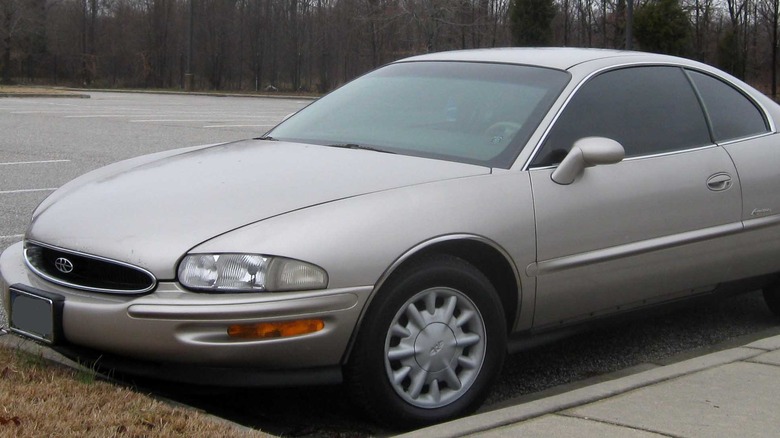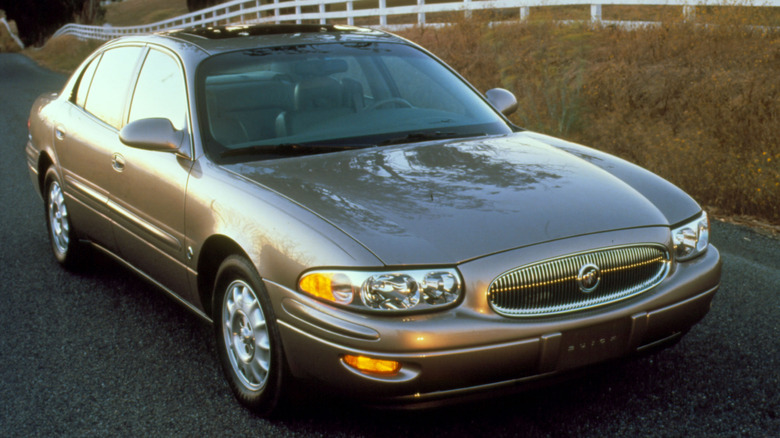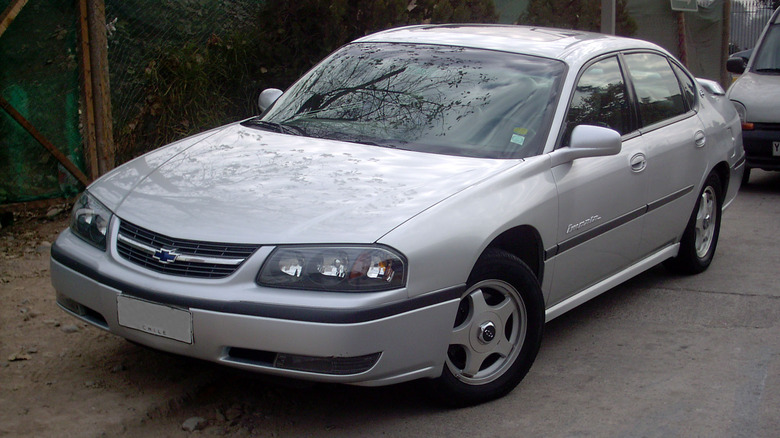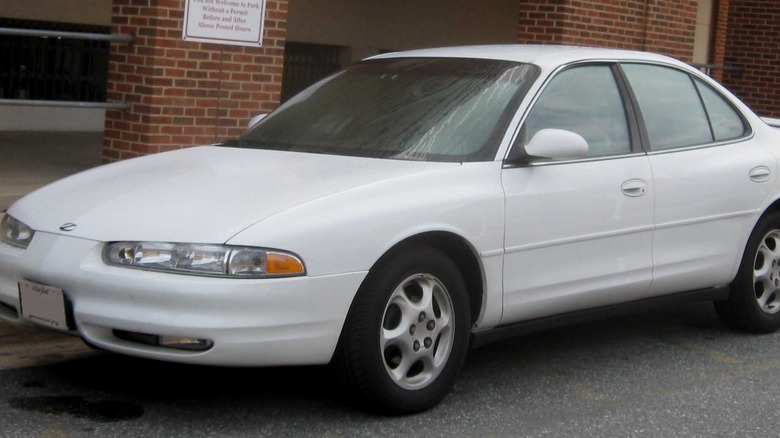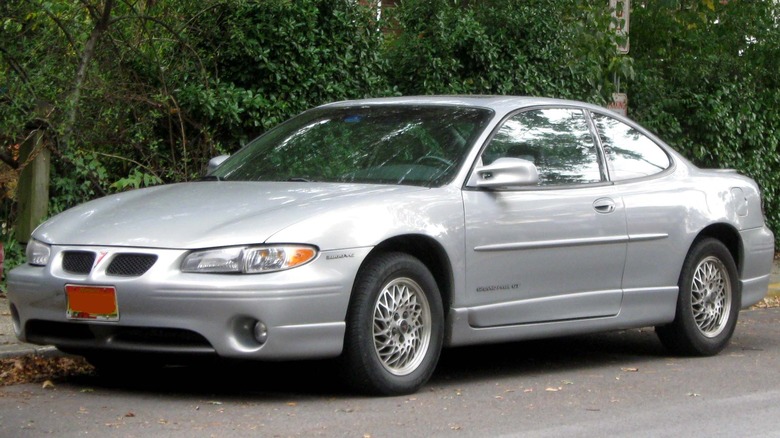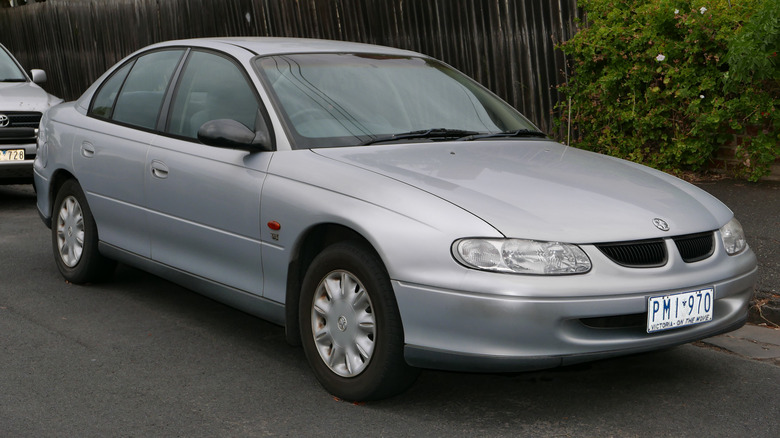Which Cars Have The GM 3800 Series II Engine Under The Hood?
When it comes to what people love to talk about regarding what powers American-made automobiles, the conversation tends to start and end with V8 engines. These are big, hulking engines that tend to be able to generate a ton of power and served as the to go-to for the height of the American muscle car craze of the 1960s and early '70s. However, there are other American-made engines out there that should be looked on with fondness. While they might not be as eye-popping as their larger siblings, there is still plenty to enjoy about V6 engines, and one of the best American V6s ever made has to be the 3800 Series II V6 from Buick and General Motors.
This particular 3.8L engine, given the name L36, made its debut in the 1995 model year and acted as a successor to the Series I L27 edition, though the 3800 as a whole had been around since the early 1960s. This was an engine that was reliable and fuel efficient, and was often named amongst the ten best engines of a given year.
The Series II V6 was not an engine for high performance vehicles, as it could generate just 205 hp, but for your basic, reliable engine to satisfy just about anyone looking for a solid car, this was a tremendous choice. Because of that, General Motors opted to make this the standard-bearer engine for many of its vehicles across a number of brands. Let's see exactly where you'd be able to get yourself a L36 V6.
[Featured image by IFCAR via Wikimedia Commons | Cropped and scaled | Public Domain]
The Buicks
To start alphabetically, we kick things off with the brand that originally developed the 3800 V6 engine all the way back in the 1960s, Buick. Overall, the L36 found itself powering four different vehicles in Buick's stable, usually being the base-level engine for these models. The first car it was available for was the Buick Riviera for its 1995 model year. This was the eighth generation for this two-door coupe that had been using the Series I L27 for a number of years, so with a new generation came a new engine. That tends to be the case with a lot of the vehicles the L36 was put into, as this was essentially the upgraded version of the previous generation.
Buick would subsequently roll out the L36 3800 on three more models over the next two years. The 1996 model year saw it placed under the hood of a Buick LeSabre four-door sedan. The following year, it was added to both the Park Avenue and Regal. Like the LeSabre, these are both four-door sedans with the Regal being the more luxury version of the Buick Century, which didn't feature the L36. In the case of all four vehicles, the 3800 V6 would be the engine you would get either for the rest of the vehicle's lifespan or until the Series II was supplanted by the Series III L26 in 2005, whichever came first.
Series II also featured a supercharged version of the L36 called the L67, which could be found in the Buick Regal GS and supercharged Park Avenue and Riviera models.
The Chevrolets
Buick may have been quick to put the Series II 3800 V6 into its vehicles, but for Chevrolet, another brand under the General Motors umbrella, it took a few more years before it made an impression. That was mostly true but featured one exception, the Chevrolet Camaro. In that first 1995 model year, you were given the option of the L36 V6, but the standard Camaro engine of the time was a 3.4L V6. That optionality was short-lived, as the L36 became standard for the two-door coupe the next year.
The 3800 wouldn't make its way into another Chevrolet until 1998, but in the end, it actually wound up in more Chevrolets than Buicks. That year, it was an option for both the Chevy Lumina and Monte Carlo models, except it was not for the base-level iterations and instead for their higher performance models. This was the engine that came standard with the Monte Carlo Z34, and for the Lumina, it was exclusively for the Lumina LTZ, though it was an option and not standard. In both cases, its usage only lasted two model years. That was just in the United States, as the CD variation of the Chevy Omega came with the V6 in Brazil as well.
Two years later, Chevrolet resurrected the Impala four-door sedan after four years of no production. With that revival, the company opted to equip it with the L36, and for 2004, the L67 supercharged version was also an option.
[Featured image by order_242 via Wikimedia Commons | Cropped and scaled | CC BY-SA 2.0]
The Oldsmobiles
Oldsmobiles were also incredibly quick to embrace the new L36 3600 V6 engine. The brand didn't just kick off the 1995 model year with one vehicle using it as its engine. Instead, it immediately put it into two. These were the Oldsmobile 88 and 98. Both of these four-door sedans had been around since the 1940s, and both of them met their ends before the 2000 model year, with the 98 getting discontinued in 1996 and the 88 three years later. That means the L36 was around for both of their final years, as was the L67 for the supercharged versions. In the case of the 88, the L36 was also used for its performance LSS and Regency models too.
Despite such an immediate usage by Oldsmobile, only one other model form the brand would use the 3800 V6, and it wouldn't be until the 1998 model year for the short-lived four-door sedan the Oldsmobile Intrigue. This was the inaugural engine for this car, and though it remained in production until the 2002 model year, the engine's usage in it would only be through 1999. Afterwards, it was replaced by the 3.5L LX5 V6 engine from General Motors' Northstar engine family. Oldsmobile was the one brand that adopted the L36 3800 V6 engine that didn't end up using it after moving into the 21st Century, even though others were comfortably using it until 2005 when the Series III upgrade occurred.
[Featured image by IFCAR via Wikimedia Commons | Cropped and scaled | Public Domain]
The Pontiacs
General Motors still had one other brand it wanted to put the Series II V6 engine into for the United States, and that was Pontiac. Out of all the GM brands mentioned thus far, Pontiac was the one that had the fewest number of models adopt the L36 or L67. Despite it not being a widely used engine, it did manage to remain the engine for those cars quite a bit longer than many of the other aforementioned vehicles. As you would expect, though, all of the Pontiacs it was used for were four-door sedans, as well as a two-door coupe for one of the models.
The 1995 model year saw the L36 become the engine for the company's Bonneville model, and for those who wanted a supercharged version of the sedan, the L67 V6 was also an option. The Bonneville had been using the Series I prior to this, so the transition over to the new models was something rather obvious and seamless for Pontiac to do. One year later, the L36 would become the standard engine for the Pontiac Firebird as well. Unlike the Bonneville, the higher performance V6 would not be the upgraded option for the car, and instead a 5.7L LT1 V8 would be used for that.
Pontiac would then make the L36 and L67 available for the Grand Prix in the 1997 model year. In contrast to the Bonneville and Firebird, the L36 would not just become the engine for the base model. Instead, either engine would have to be an upgraded option from a 3.1L V6.
[Featured image by IFCAR via Wikimedia Commons | Cropped and scaled | Public Domain]
The Holdens
The spread of the L36 3800 V6 may have ended there for General Motors in the United States, but that does not mean it wasn't used elsewhere in the world. Over in Australia, GM had taken up the car company Holden as a subsidiary, and it ended up using the regular and supercharged versions of the 3.8L engine for several of its vehicles at the time. While these were the same engines as the ones used in the United States, Holden and GM had placed them under the Ecotec banner, a type of engine for GM that implemented more advanced emissions control technology.
There was no delay in waiting to see results from the United States to bring the V6 to Australia, as Holden put it into two different vehicles in 1995. The Series II engine was placed under the hood of both the Holden Commodore and Caprice models. Each came as a four-door sedan, but a two-door coupe was also available for the Commodore. These would be the sole uses of the 3800 for the company until the 2000 model year, when it was introduced as the base engine for the Holden Ute two-door coupe. No other Holden cars would utilize the Series II engines, though the Commodore did also offer the supercharged L67 V6 as an option.
[Featured image by OSX via Wikimedia Commons | Cropped and scaled | Public Domain]
